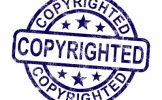 |
| (Image courtesy of Stuart Miles / FreeDigitalPhotos.net) |
In our right-click Internet society, it's only a matter of time before you find that someone has used your work without your permission. Fortunately, copyright law for artists allows you several methods that can stop copyright infringement in its tracks.
Sometimes, having your work posted elsewhere can be helpful to your business — for example, when a well-known fashion blogger "pins" one of your jewelry designs. But other times, the use doesn't jive with your brand or someone is profiting off your work and you want to stop it.
What can you do about it? Two primary tools you can use to stop copyright infringement are: a DMCA take-down notice and a cease and desist letter.
DMCA take-down notice
Because you can easily draft and send a DMCA take-down notice yourself, it is one of the most powerful tools you have to stop copyright infringement. In just three simple steps, you can complete a DMCA take-down notice.
Step 1. Determine the Website Host. Sometimes, you'll luck out and your work will appear on sites like Facebook or Pinterest, which are self-hosted sites. But how do you find the host for stand-alone sites? I usually check DomainSigma first. If DomainSigma doesn’t help, then usually a WHOIS search combined with a DNS lookup will get you the information you need.
One big note: Since the DMCA take-down notice is U.S. law, if the host is not based in the United States it does not have to comply. However, some
countries have similar procedures to take down infringing content (e.g. the European Union and Australia).
Step 2. Determine Where and Whom to Send the Notice. Now that you have the name of the host, the next step is to determine whom to address the notice to (AKA the Copyright Agent) and where to send it. Again, many hosts have an established process that they want you to use (e.g.
Facebook or Pinterest). Often you can find this information by looking in the footer of the host's website for language similar to "Copyright/IP Policy." If it's not there, the U.S. Copyright Office has a list of whom and where to send the notice here.
Step 3. Draft and Submit the Notice. To comply with the DMCA, your notice must:
- Be in writing,
- Be signed by the copyright owner or an agent of the copyright owner (an electronic signature is OK),
- Identify the copyrighted work that is being infringed,
- Identify the infringing material,
- Include your contact information,
- State that you are acting in "good faith,"
- State that "under penalty of perjury, that the information contained in the notification is accurate", and
- State that you have the right to proceed (since you are the copyright owner).
Again, if there is an established process, their form will contain all of the above elements. If not, then you'll have to draft your notice to include all of the above elements. Once you draft your notice, submit it using the information you found in Step 2.
The website's host then must remove the infringing content within a reasonable time (often one to three business days). The other party has the right to prepare and submit a counter-notice and get the content re-instated, but this usually does not happen.
Bingo! It's just that simple to prepare and send a DMCA take-down notice.

How To Build an Artist Website
Sign up for our newsletter and get the book How to Build an Artist Website for free!
Cease and Desist Letter
The other tool that you can use to stop copyright infringement, under copyright law for artists, is a cease and desist letter. Generally, this is most helpful when: a counter-notice reposts the material, someone is profiting off your work, you have registered your work with the U.S. Copyright Office, or the infringement is occurring offline.
Some artists successfully send their own cease and desist letters, but there is a perceived value for cease and desist letters on attorney letterhead. This is because the other party (and the other party's attorney, if there is one) will know that you have spent money to have that letter prepared and as such, are much more likely to know and understand your rights.
Have you tried either of these methods successfully?
(I'm a lawyer, so my insurance carrier likes me to use disclaimers. The information in this post is made available for educational purposes only, not to provide specific legal advice. I am not your attorney and this post is not a substitute for competent legal advice from a licensed attorney in your state.)

Guest poster Kiffanie Stahle lives in San Francisco and is the founding partner of Stahle Law, where she provides copyright and trademark services to creatives of all kinds. She tries to make law a little less scary by giving her clients the tools they need to understand their legal rights and when to get assistance rather than forging ahead on their own. She loves to take photographs and occasionally will show them in public.




